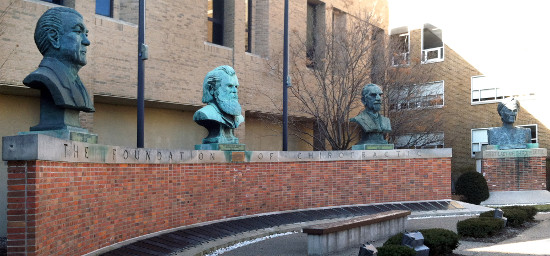
In the Heritage Court on the Palmer College of Chiropractic campus (at 1000 Brady Street in Davenport) are four large bronze busts. Sculptures of D.D. Palmer, his son B.J. Palmer, and his grandson David Palmer are placed symmetrically on a curved brick and stone wall with the incised words "The Foundation of Chiropractic." These men collectively presided over the Palmer College of Chiropractic for its first 81 years, beginning with its founding in 1897.
Slightly to the north is a bust of Mabel Heath Palmer, who is recognized as the "First Lady of Chiropractic" and was B.J.'s wife and David's mother.
Created by three different artists over a period of nearly 70 years, the sculptures are stylistically distinct. They are unified, however, by their consistency in height. Each bust is approximately five feet tall. Positioned on the two walls, they each reach a total height of about 12 feet. They also work together because of the consistent use of materials and conformity to a sculptural form from antiquity - the bust. During the Roman Empire, important families celebrated their achievements and honored their deceased relatives by displaying these sculpted portraits prominently and publicly.
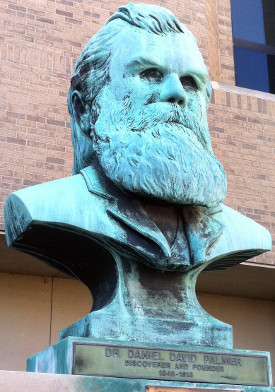 The central bust of Dr. Daniel David (D.D.) Palmer (1845-1913) has a commanding quality. The founder of chiropractic care, D.D. Palmer performed the first spinal adjustment in 1895. Two years later, he founded the Palmer school. To put these dates in perspective with other health-care milestones, viruses were discovered only three years before the first adjustment; more than a decade would pass before the first vitamins were discovered.
The central bust of Dr. Daniel David (D.D.) Palmer (1845-1913) has a commanding quality. The founder of chiropractic care, D.D. Palmer performed the first spinal adjustment in 1895. Two years later, he founded the Palmer school. To put these dates in perspective with other health-care milestones, viruses were discovered only three years before the first adjustment; more than a decade would pass before the first vitamins were discovered.
Befitting the title of "Discoverer and Founder" on the plaque at its base, the sculpture's deep-set eyes seem to gaze to the horizon. The solemn face is framed by a classically stylized, magnificent beard. Though not signed or dated, the bust is attributed to a chiropractic student, George Barton. It was unveiled to the public in 1921.
The bust of Dr. Bartlett Joshua (B.J.) Palmer (1881-1961) was created by Luis Antonio Sanguino, an internationally renowned sculptor whose expressive and gestural style was well-suited to his monumental The Immigrants in New York and to his massive sculptures of bullfighters in Madrid. Sanguino's use of rugged textures gives the bust an energetic surface that reflects the active life of its subject.
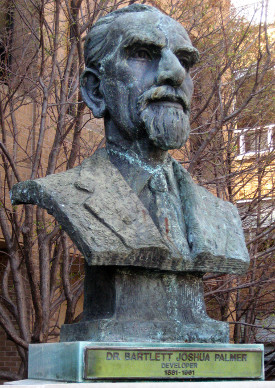 B.J. Palmer assumed responsibility for the Palmer School of Chiropractic in 1904 while still in his early 20s. He would preside over the college for more than a half-century. The author of 38 books, B.J. also amassed a collection of artworks and artifacts from his world travels. His Little Bit o' Heaven, which included live alligators, was a Quad Cities tourist attraction for more than two decades.
B.J. Palmer assumed responsibility for the Palmer School of Chiropractic in 1904 while still in his early 20s. He would preside over the college for more than a half-century. The author of 38 books, B.J. also amassed a collection of artworks and artifacts from his world travels. His Little Bit o' Heaven, which included live alligators, was a Quad Cities tourist attraction for more than two decades.
Among his many enterprises, he was president of the Central Broadcasting Company, Tri-City Broadcasting Company, Stereocolor (a pioneering Technicolor and 3D studio in California), and the International Chiropractors Association; owner of the Clear View Sanitarium; director of the B.J. Palmer Chiropractic Research Clinic; and a supporter of Sarasota, Florida's Circus Hall of Fame.
Among the first to understand the potential of radio, B.J. purchased WOC radio in 1922. The call letters, though assigned arbitrarily by the government, became known to stand for "Wonders of Chiropractic." Operating atop the Palmer school, the station was the first commercial station west of the Mississippi and one of the most powerful in the nation. WOC branched into television in 1949.
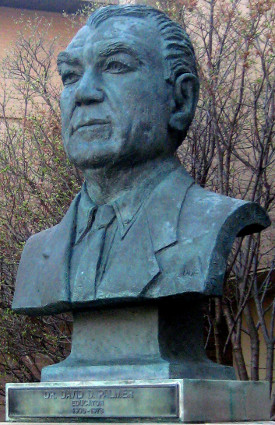 Following B.J. Palmer's death, his son Dr. David D. Palmer (1906-1978) became the third president of the college. Projecting a sense of confidence and steadfastness, the bust of David Palmer is nonetheless more conventional than the others. It was created by his wife Dr. Agnes Mae High Palmer, who was both a chiropractor and a sculptor.
Following B.J. Palmer's death, his son Dr. David D. Palmer (1906-1978) became the third president of the college. Projecting a sense of confidence and steadfastness, the bust of David Palmer is nonetheless more conventional than the others. It was created by his wife Dr. Agnes Mae High Palmer, who was both a chiropractor and a sculptor.
The school became the Palmer College of Chiropractic under David Palmer's leadership. In addition to obtaining not-for-profit status for the college and forming its first board of trustees, he laid the foundation for the college's accreditation. The faculty tripled in size.
The bust of Dr. Mabel Heath Palmer (1881-1949) was also created by Agnes Mae High Palmer. Though it is approximately the same size as the others, the angular shoulders and facial details as well as the strong patterning in the clothing and turban make it strikingly different. Set directly on its base, it seems more massive than the other three, which rise from slender stands.
Mabel Palmer became a doctor of chiropractic in 1905 and founded the Sigma Phi Chi sorority, the oldest continuous chiropractic organization, in 1911. A recognized authority on anatomy and a teacher for more than 30 years, she earned the title "First Lady of Chiropractic" and her rightful place in the Heritage Court.
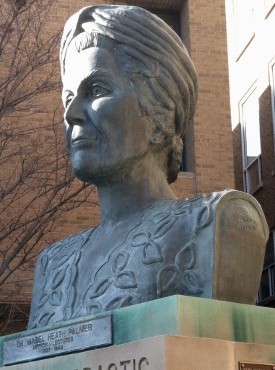 The sculptures and wall are clearly meant to be viewed from the paved court. However, a small plaque on the back of the central and oldest sculpture states, "Herein rest the ashes of Daniel David Palmer." A similar plaque is on the back of his son's bust.
The sculptures and wall are clearly meant to be viewed from the paved court. However, a small plaque on the back of the central and oldest sculpture states, "Herein rest the ashes of Daniel David Palmer." A similar plaque is on the back of his son's bust.
When one considers that a growing health-care field with some 75,000 practitioners was founded here, that this college is held as the fountainhead of its profession, and that the ashes of the founder and developer are interred here, these four busts convey an appropriate sense of importance and dignity.
Bruce Walters is a professor of art at Western Illinois University.
This is part of an occasional series on the history of public art in the Quad Cities. If there's a piece of public art that you'd like to learn more about, e-mail the location and a brief description to BD-Walters@wiu.edu.








